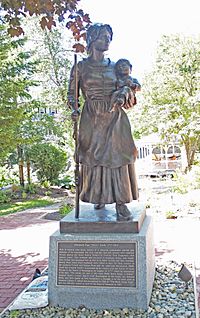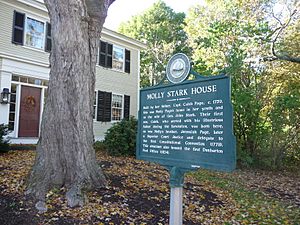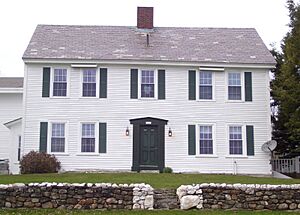Molly Stark facts for kids
Quick facts for kids
Molly Stark
|
|
|---|---|

Statue of Molly Stark in Wilmington, Vermont
|
|
| Born |
Elizabeth Page
February 16, 1737 |
| Died | June 29, 1814 (aged 77) |
| Resting place | Manchester, New Hampshire |
| Spouse(s) | General John Stark (m. 1758) |
| Children | 11, including Caleb Stark |
| Relatives | Harriet Lane Huntress |
| Molly Stark House | |
|---|---|
 |
|
| Location | 346 Stark Highway North, Dunbarton, New Hampshire |
| Built | c. 1759 |
|
N.H. State Register of Historic Places
|
|
| Designated | January 27, 2003 |

Molly Stark, whose real name was Elizabeth Page (born February 16, 1737 – died June 29, 1814), was an important woman during the American Revolutionary War. She was married to General John Stark, who became famous for his inspiring battle cry. Molly was known as a mother of 11 children, a dedicated homemaker, and a strong supporter of her country. Many places and landmarks in several states are named after her.
Contents
Molly Stark's Early Life and Family
Elizabeth Page was born in Haverhill, Massachusetts, on February 16, 1737. Her parents were Caleb Page and Elizabeth Merrill. Her father was a successful businessman and a leader in the local militia.
When Elizabeth was five, her mother passed away. She was then adopted by her aunt, Ruth Wallingford, who already had 10 children. Elizabeth lived with the Wallingfords for 10 years.
In 1752, at age 15, she returned to live with her father in Starkstown, which is now Dunbarton, New Hampshire. On August 20, 1758, she married John Stark. It was John who gave her the nickname "Molly." Together, they had 11 children, including their oldest son, Caleb Stark.
Molly Stark During the American Revolution
Molly Stark became well-known because of her husband's famous battle cry. Before the Battle of Bennington, General Stark told his troops, "There are your enemies, the Red Coats and the Tories. They are ours, or this night Molly Stark sleeps a widow!" This meant they had to win, or he wouldn't come home.
Molly Stark was also known for helping her husband's soldiers. During a smallpox outbreak, she worked as a nurse for the troops. She even opened their home to be used as a hospital during the war.
She passed away on June 29, 1814. Molly Stark was buried in Manchester, New Hampshire.
Molly Stark's Lasting Legacy
Molly Stark's name is still very popular today. You can find it on many schools, parks, streets, and businesses. People continue to honor her for her contributions and spirit.
Vermont Honors Molly Stark
In Wilmington, Vermont, you can visit the Molly Stark State Park. There is also a statue of Molly Stark in downtown Wilmington. The statue shows her holding a child and a musket.
The Molly Stark Trail is another name for Vermont Route 9. This road crosses southern Vermont. It marks the path General Stark took after his victory at the Battle of Bennington. There is also a Molly Stark Elementary School in Bennington.
Molly Stark Mountain is one of the Green Mountain peaks. It is part of the Long Trail, located south of Camel's Hump. The peak next to it is called Baby Stark.
New Hampshire Honors Molly Stark
The Molly Stark House still stands in Dunbarton, New Hampshire. It is located at Page's Corner and has a New Hampshire historical marker (number 111). The house was added to the New Hampshire State Register of Historic Places in 2003.
The Molly Stark cannon, also called "Old Molly," is named after her. The New Boston Artillery Company keeps this cannon. It also has a New Hampshire historical marker (number 146). The Molly Stark Chapter of the Daughters of the American Revolution is located in Manchester, New Hampshire.
Ohio Honors Molly Stark
Many veterans of the Revolutionary War settled in Ohio. Because of this, General Stark and his wife were honored there. Molly Stark Park is in Nimishillen Township, Stark County.
This park used to be the site of the Molly Stark Hospital. The hospital treated people with tuberculosis from 1929 to 1956. Later, it was a general hospital until 1995. In 2008, the county park board bought the hospital grounds for one dollar. The county opened the first public park in the township in April 2009.
Minnesota Honors Molly Stark
Molly Stark Lake in Otter Tail County, Minnesota, is also named after her.

